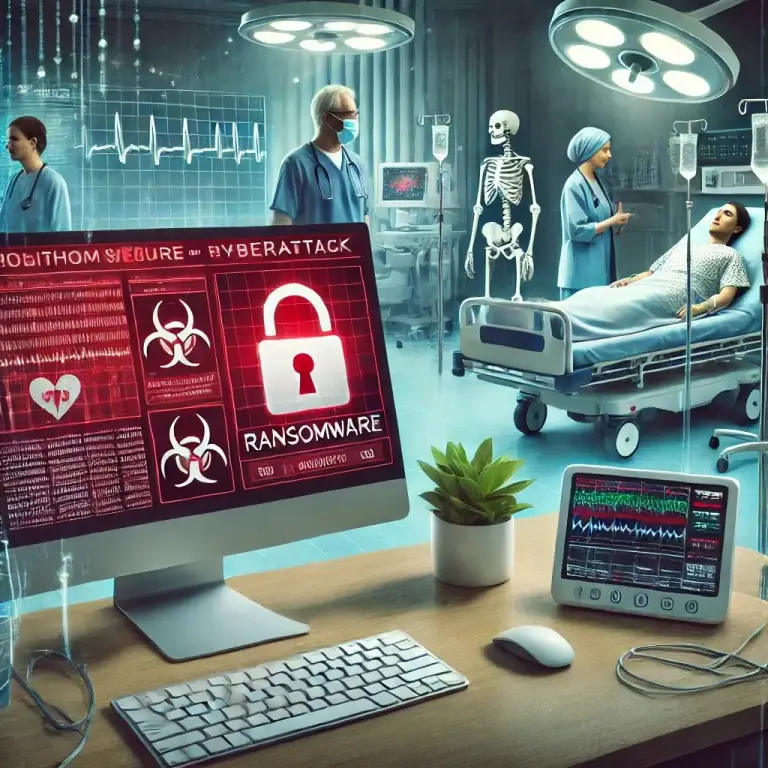
In recent years, technology has transformed the healthcare sector, improving patient outcomes, enhancing administrative efficiency, and revolutionizing disease management. However, as health tech advances, so do the cybersecurity risks that threaten sensitive patient data and the overall safety of healthcare systems. This blog delves into the dark side of health tech, exploring key cybersecurity risks like data breaches in healthcare systems, ransomware, and strategies to mitigate these threats effectively.
The Intersection of Health Tech and Cybersecurity
The integration of technology in healthcare has introduced interconnected systems, electronic health records (EHRs), wearable health devices, and telemedicine platforms. While these innovations improve accessibility and efficiency, they also create vulnerabilities, increasing risks like ransomware in hospitals and IoT vulnerabilities in healthcare.
Key Risks in Health Tech
1. Data Breaches in Healthcare Systems
Healthcare organizations are treasure troves of sensitive data, including personal information, medical histories, and financial details. These data breaches in healthcare systems often occur due to weak security measures, making them prime targets for cybercriminals aiming to steal and monetize such information.
2. The Impact of Ransomware on Hospitals
Ransomware, a type of malware that locks systems and demands payment for restoration, is a growing threat in healthcare. These attacks disrupt operations, delay treatments, and jeopardize patient safety, highlighting the need for robust ransomware mitigation strategies.
3. IoT Vulnerabilities in Healthcare Devices
Internet of Things (IoT) devices, such as connected pacemakers and insulin pumps, often have minimal security protocols. Hackers exploiting IoT vulnerabilities in healthcare devices could harm patients or create operational disruptions.
4. Third-Party Risks in Healthcare Cybersecurity
Many healthcare systems rely on third-party vendors for software and services. When these vendors fail to implement adequate cybersecurity measures, they become weak links, exposing healthcare systems to potential data breaches and cyberattacks.
5. Insider Threats to Cybersecurity
Employees with access to sensitive data can inadvertently or intentionally compromise system security. Addressing insider threats is essential for safeguarding healthcare data and mitigating potential breaches.
Real-World Cybersecurity Incidents in Healthcare
1. WannaCry Attack on NHS (2017)
The WannaCry ransomware attack severely affected the UK’s National Health Service (NHS), disrupting services at over 80 hospitals. This incident underscores the devastating impact of ransomware on hospitals and highlights the importance of investing in cybersecurity.
2. Singapore’s SingHealth Breach (2018)
Hackers stole personal data, including prescription details, of 1.5 million patients from SingHealth, Singapore’s largest healthcare group. This breach exposed vulnerabilities in centralized electronic health records and emphasized the need for robust security in healthcare systems.
3. U.S. Health Systems Targeted During COVID-19
During the pandemic, cyberattacks on U.S. health systems, including ransomware incidents, hindered their ability to provide timely care. These events showcased the growing importance of implementing cybersecurity in healthcare.
Consequences of Cybersecurity Breaches in Healthcare
1. Patient Safety Risks
Cyberattacks disrupt critical healthcare services, jeopardizing patient safety. For example, delayed treatments caused by ransomware in hospitals can lead to preventable fatalities, emphasizing the importance of securing healthcare systems.
2. Financial Losses
The financial impact of data breaches in healthcare systems is significant. Hospitals face expenses from ransom payments, lawsuits, and restoring compromised systems, making cybersecurity a critical investment.
3. Erosion of Trust
Patients expect their sensitive data to remain confidential. Breaches erode trust, leading patients to withhold critical information and affecting the quality of care provided.
4. Regulatory Penalties
Failure to comply with regulations like HIPAA results in hefty fines for healthcare organizations. These penalties highlight the need for proactive strategies to mitigate healthcare cyber risks.
Why Healthcare is a Prime Target for Cyberattacks
1. High Value of Data
Medical records contain comprehensive personal information, making them highly valuable. Data breaches in healthcare systems are especially lucrative for cybercriminals compared to other industries.
2. Outdated Systems
Legacy systems used by many healthcare facilities lack compatibility with modern security protocols, making them vulnerable to breaches and other cyber risks in healthcare.
3. Limited Budgets
Budget constraints often lead healthcare providers to prioritize operational needs over cybersecurity investments, creating vulnerabilities that cybercriminals exploit.
4. Increased Interconnectivity
As healthcare systems adopt more interconnected devices, the risk of cyberattacks increases. Addressing IoT vulnerabilities in healthcare is essential to mitigate these risks.
Proactive Steps to Mitigate Cybersecurity Risks in Healthcare
1. Implementing Robust Cybersecurity Protocols
Healthcare organizations must adopt advanced security measures, including multi-factor authentication, encryption, and regular system updates, to mitigate healthcare cyber risks effectively.
2. Employee Training for Cybersecurity in Healthcare
Training staff to recognize phishing scams, secure passwords, and follow cybersecurity best practices is crucial for reducing human errors that lead to data breaches in healthcare systems.
3. Regular Risk Assessments
Conducting security audits and vulnerability assessments helps healthcare organizations identify and address weaknesses before they are exploited.
4. Investing in AI-Driven Security Tools
Advanced technologies, such as AI-driven tools, can detect and respond to threats in real-time, minimizing the impact of ransomware and other cyberattacks on healthcare systems.
5. Strengthening Vendor Management
Ensuring third-party vendors follow strict cybersecurity standards helps mitigate risks from external partners and protects sensitive healthcare data.
6. Developing Incident Response Plans
Having a well-tested incident response plan ensures organizations can quickly recover from cyberattacks and minimize disruptions.
Conclusion: Safeguarding Healthcare from Cybersecurity Risks
While technology has revolutionized healthcare, it has also exposed the industry to significant cybersecurity risks. To address issues such as data breaches, ransomware, and IoT vulnerabilities, healthcare organizations must prioritize robust cybersecurity measures.
By investing in proactive strategies to mitigate healthcare cyber risks, organizations can safeguard sensitive data, maintain patient trust, and continue innovating for better health outcomes.
